
Frank Heyling Furness was an American architect of the Victorian era. He designed more than 600 buildings, most in the Philadelphia area, and is remembered for his diverse, muscular, often inordinately scaled buildings, and for his influence on the Chicago-based architect Louis Sullivan. Furness also received a Medal of Honor for bravery during the Civil War.

Haverford is an unincorporated community located in both Haverford Township in Delaware County, Pennsylvania, United States, and Lower Merion Township in Montgomery County, approximately 3 miles (4.8 km) west of Philadelphia. The Pennsylvania Railroad (PRR) opened Haverford Station in 1880 on their Main Line west out of Broad Street Station in Philadelphia. Haverford sits at milepost 9.17.

The Reading Company was a Philadelphia-headquartered railroad that provided passenger and freight transport in eastern Pennsylvania and neighboring states that operated from 1924 until its acquisition by Conrail in 1976.

The Delaware and Hudson Railway (D&H) is a railroad that operates in the Northeastern United States. In 1991, after more than 150 years as an independent railroad, the D&H was purchased by the Canadian Pacific Railway (CP). CP operated D&H under its subsidiary Soo Line Corporation which also operates Soo Line Railroad.
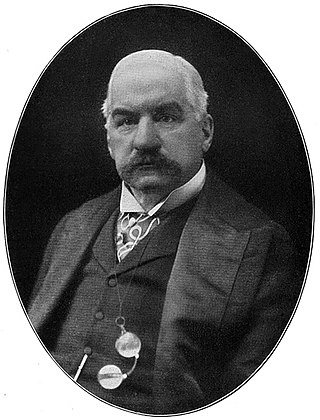
The International Mercantile Marine Company, originally the International Navigation Company, was a trust formed in the early twentieth century as an attempt by J.P. Morgan to monopolize the shipping trade.
The Lehigh and New England Railroad was a Class I railroad located in Northeastern United States that acted as a bridge line. It was the second notable U.S. railroad to file for abandonment in its entirety after the New York, Ontario and Western Railway. It was headquartered in Philadelphia.
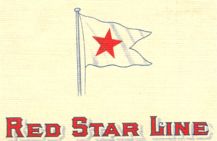
The Red Star Line was a shipping line founded in 1871 as a joint venture between the International Navigation Company of Philadelphia, which also ran the American Line, and the Société Anonyme de Navigation Belgo-Américaine of Antwerp, Belgium. The company's main ports of call were Antwerp in Belgium, Liverpool and Southampton in the United Kingdom and New York City and Philadelphia in the United States.
The International Navigation Company (INC) was a Philadelphia-based holding company owning 26 ships totaling 181,000 tons and carried more passengers than either Cunard or White Star, when the company was reorganized as International Mercantile Marine in 1902. INC was formed in 1871 with the backing of the Pennsylvania Railroad to operate foreign flagged vessels on transatlantic routes to Philadelphia. Clement Griscom, the company's general manager, entered into an agreement with the Belgian Government to establish the Red Star Line to operate a mail service out of Antwerp to Philadelphia and New York. This subsidiary would provide most of the company's profits for the next 30 years.

Clement Acton Griscom was an American shipping magnate and financier.
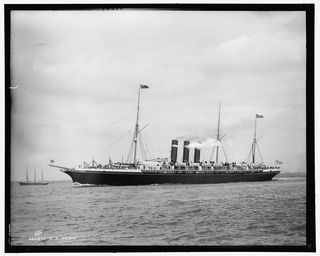
City of Paris, was a British-built passenger liner of the Inman Line that held the Blue Riband as the fastest ship on the north Atlantic route from 1889 to 1891 and again from 1892 to 1893. A sister ship of the City of New York and a rival of the White Star Line Teutonic and Majestic, she proved to be the quickest of the pre-Campania twin-screw express liners. In 1893, she was renamed Paris and transferred to US registry when the Inman Line was merged into the American Line. She and her sister were paired with the new American built St Louis and St Paul to form one of the premier Atlantic services. Paris served the US Navy as the auxiliary cruiser USS Yale during the Spanish–American War and is remembered for slipping into the harbor at San Juan, Puerto Rico, under the Spanish guns of Morro Castle. After Paris returned to commercial service, she was seriously damaged in 1899 when she grounded on The Manacles off the British coast. Rebuilt and renamed Philadelphia, she sailed for the American Line until requisitioned again during World War I as the transport Harrisburg. After the war, she continued with the American Line until 1920 and was scrapped in 1923.
The Philadelphia, Newtown and New York Railroad was a railroad in southeastern Pennsylvania that is now a part of the SEPTA commuter rail system as the Fox Chase Branch. Despite the name, it only ever extended between Philadelphia and Newtown, Pennsylvania.

Wilson Brothers & Company was a prominent Victorian-era architecture and engineering firm established in Philadelphia, Pennsylvania. The company was regarded for its structural expertise.

The Pennsylvania class was a class of four cargo-passenger liners built by the Philadelphian shipbuilder William Cramp & Sons in 1872–73. Intended for the newly established American Line, the four ships—Pennsylvania, Ohio, Indiana and Illinois—were at the time the largest iron ships yet built in the United States, and were launched with considerable fanfare. Upon entering service in 1874, they became the first American-built steamships to challenge British dominance of the transatlantic trade since the American Civil War.

SS Indiana was an iron passenger-cargo steamship built by William Cramp & Sons in 1873. The third of a series of four Pennsylvania-class vessels, Indiana and her three sister ships – Pennsylvania, Ohio and Illinois – were the largest iron ships ever built in the United States at the time of their construction, and among the first to be fitted with compound steam engines. They were also the first ships to challenge British dominance of the transatlantic trade since the American Civil War.

USS General W. C. Gorgas (ID-1365) was a United States Navy troop transport in commission in 1919, named for William C. Gorgas. It was a German ship seized by the US Shipping Board after the US entered World War I. Under charter from 1917 from the Panama Railroad Company, it had carried troops and supplies to Europe. After being used as a troop transport to return troops from Europe in 1919, later that year it was converted back to commercial use as a passenger and freight ship operated by the Panama Railroad Company.
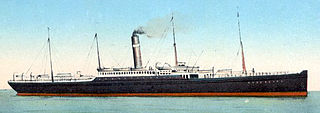
SS Merion was an ocean liner built in 1902 for the American Line, a subsidiary line of the International Mercantile Marine (IMM). She also sailed for the Red Star Line and the Dominion Line—both subsidiary lines of IMM—during her passenger career. After the outbreak of World War I she was bought by the British Admiralty and converted to serve as a decoy resembling the Royal Navy battlecruiser HMS Tiger. In May 1915, while posing as Tiger in the Aegean Sea, Merion was sunk by the German submarine SM UB-8.

George Brooke Roberts was a civil engineer and the fifth president of the Pennsylvania Railroad (1880–96).

SS Haverford was an American transatlantic liner commissioned in 1901 for the American Line on the route from Southampton to New York, then quickly on the route from Liverpool to Boston and Philadelphia. During her early years, this ship, mainly designed to transport migrants and goods, was the victim of several incidents. Her company was integrated into the International Mercantile Marine Co. (IMM) in 1902 and she was used by other companies within the trust, the Dominion Line and the Red Star Line.
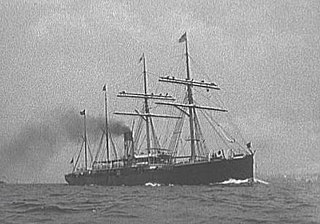
SS Rhynland was a passenger ship owned by the Red Star Line. She was built in 1879 by Barrow Shipbuilding Company. The ship was sold to Italy in 1906, renamed Rhyna, and was subsequently scrapped.
The Pithole Valley Railway was an ephemeral short line railroad in Venango County, Pennsylvania, constructed as a result of the Pennsylvania oil rush. The railroad was originally constructed in 1865 between Oil City, Pennsylvania, a local oil transportation hub, and the boomtown of Pithole, Pennsylvania. Constructed under the charter of the Clarion Land and Improvement Company, it was informally known as the Oil City and Pithole Branch Railroad. Although it was generally supported by the broad gauge Atlantic and Great Western Railway, it was built to standard gauge. Conflict with the Warren and Franklin Railway over the right-of-way along the Allegheny River led to a lawsuit which, in 1866, declared that the Oil City and Pithole had no right to operate along the river from Oleopolis, Pennsylvania to Oil City. That part of the line was sold to the Warren and Franklin, leaving the Oil City and Pithole with a 7-mile (10 km) line running north from Oleopolis to Pithole along Pithole Creek.


















